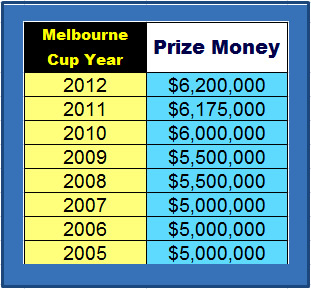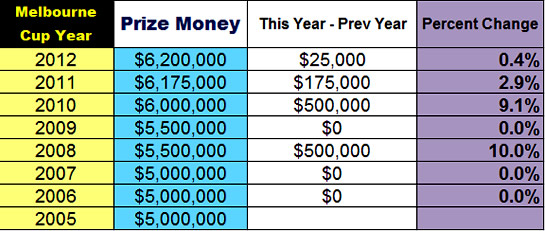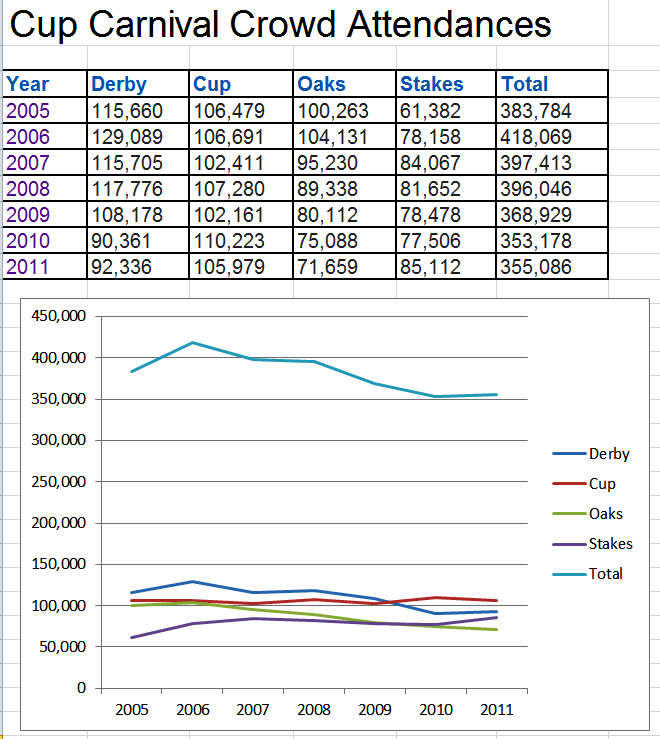
Image Source: http://www.theepochtimes.com
Bart Cummings is the “Cups King” – the horse trainer who has won more Melbourne Cup races than anyone. Long Live the King!
In this lesson we look at some of the mathematics associated with Austrlia’s premier horse racing event: “The Melbourne Cup” which is held annually on the first Tuesday in November.
It is a long race totalling 3200 meters, (Or around 2 miles), and lasts for around three and a half minutes.
There is very large prize money on offer, and it attracts an international field of champion race horses.
With the actual horse race only a few days away, this lesson is a bit of a rushed job. We hope to add more to it at a later stage, and have a fuller list of items here for the 2013 Melbourne Cup.
Betting Odds

Image Source: http://www.theage.com.au
If you placed a bet of $1 on a horse, what dividend would be payed to you if the horse won?
Odds can be a bit misleading, so it is always worth also looking at the actual probability of winning.
For every winner, there are plenty of people who invest their money for zero return.
The information at the following link explains the difference between odds and probability.
http://mathforum.org/library/drmath/view/56701.html
The Odds always give the track “bookie” or the betting company the edge.
Melbourne Cup Statistics

Image Source: Picture on Google but could not be found on Getty Images website
The following website has some great Melbourne Cup Facts and Figures:
http://www.races.com.au/melbourne-cup/melbourne-cup-history/facts-and-statistics/
Here are a few interesting facts and figures.
Melbourne Cup Barrier Statistics
•Barrier 18 is the only gate never to produce a winner since barriers came in in 1924
•The most successful barriers have been 9 – 12 with four victories in the past 11 years
Melbourne Cup Saddlecloth Statistics
Numbers 4 and 12 are the most successful boasting 11 wins
•No 4 and No 12 with 11 wins
•No 1 with 9 wins
•No 8 with 8 wins
•No 11 with 7 wins
•TAB numbers 4 and 6 have won four of the last fifteen Cups.
•TAB numbers to win only one Cup are 26, 28 and 39.
•TAB numbers to win only two Cups are 7, 16, 18, 21, 23 and 25
Melbourne Cup Winner Stats – Age
•Four and five year old horses have the best record with 43 winners each
•In the past 11 years however six-year-olds have won five times most recently Dunaden (2011)
•Only two eight-year-olds have won the Melbourne Cup
Melbourne Cup Winner Stats – Horse Type
•In the past 12 years five Melbourne Cup winners were mares
•Stallions (Entires) hold the record with 64 wins
•Entire 64
•Gelding 50
•Colts 21
•Mares 13
•Fillies 3
Melbourne Cup Weight Facts
•In the past decade the average Melbourne Cup weight carried to victory is 54kg
•Heaviest weight carried to victory was Carbine, sire of Phar Lap, with 10 stone 5 pounds (66.0kg) in 1890
•Phar Lap actually carried the highest weight with 10stone 10lg (68kg) but lost
•Lowest Weight carried to victory was Banker with just 33.5kg in 1863
Melbourne Cup Winning Colours
•17 cup winning jockeys have worn black as their main colour, the last being George Podmore on Evening Peal in 1956.
•Navy blue and royal blue with 14 wins
Melbourne Cup Betting Favourites
•Melbourne Cup betting favourites have won 32 times in 151 years, eg. only about 20% of the time.
Information Source: http://www.races.com.au/melbourne-cup/melbourne-cup-history/facts-and-statistics/
Total Prize Money

Image Copyright 2012 by Passy’s World of Mathematics
Information Source: http://en.wikipedia.org/wiki/Melbourne_Cup
The above table shows the total prize money for the Melbourne Cup Race over the last few years.
The first 10 horses past the post receive prize money.
In the 2011 race, with a total prize pool of $6,175,000 – the winner was paid $3.3 million, and tenth place $115,000.
Prize money is distributed to the connections of each horse in the ratio of 85 percent to the owner, 10 percent to the trainer and 5 percent to the jockey.
So for the first place horse in 2011, how much did the trainer and jockey each receive ?
For the tenth place of $115,000 how much did the trainer and jockey each receive ?
A further activity would be to draw a side by side comparison bar chart for these dollar figures.
Another mathematical exercise we can do on this data, is determine how much the total prize money has increased each year, as a percentage of the previous year.
Here are the answers we obtained using a Microsoft Excel Spreadsheet.

Image Copyright 2012 by Passy’s World of Mathematics
Crowd Attendances at Melbourne Cup Carnival

Image Source: http://static.stuff.co.nz
From what we hear and see in the Media here in Australia, crowds at the racing are portrayed as being huge and ever increasing.
For example, here is a media report from the internet relating to the 2011 Melbourne Cup.
“The four days of the Melbourne Cup Carnival attracted the four biggest attendances of any racing event in Australia:
AAMI Victoria Derby Day: 92,336
Emirates Melbourne Cup Day: 105,979
Crown Oaks Day: 71,659
Emirates Stakes Day: 85,112
2011 Melbourne Cup Carnival Total: 355,086 (1,908 more than 2010) ”
Information Source: http://formguide.cyberhorse.com.au
A full set of historical crowd attendances at all Cup Carnival Events is available at the following web page:
http://melbournecup.com/racing/race-results-statistics/track-attendances/
This data provides opportunities for a number of Graphing and Statistics activities.
For example, here at Passy World we examined the last few years of cup races, and obtained the following results.

Image Copyright 2012 by Passy’s World of Mathematics
(Click the above Image to view full size)
As can be seen quite clearly: Melbourne Cup attendance is fairly steady, Derby Day and Oaks Day have both been declining, but Stakes Day (possibly due to recent Emirates Airlines sponsorship and profile raising) has been increasing.
Oaks Day is traditionally a ladies day of fashions at the races and occurs on the Thursday following Melbourne Cup Day in November each year. An interesting activity would be to use Calendars and Melbourne Weather records to see if there is a correlation between Oaks Day attendance figures and the Weather.

Image Source: http://resources0.news.com.au
Eg. We could Graph Oaks Day Attendance against Daily Temperature, and determine a “Line of Best Fit and the “Correlation Coefficient”. There is a great free online graphing application that does this sort of analysis at the following link:
http://nlvm.usu.edu/en/nav/frames_asid_144_g_4_t_5.html?open=activities
We may also be able to graph Attendance against Wind Speed and check for Correlation.
As both Oaks Day and Derby Day Attendances have been declining the last few years, we could also do a Correlation between these two events and see if there is any mathematical relationship.
Additional Ideas for Cup Day Mathematics

Image Source: http://www.abc.net.au
Jackie from the Home School Learning website has 20 great ideas for educational Melbourne Cup Activities at the following link:
http://www.homeschoollearning.com.au/?p=1698
Here are three of her ideas worth considering for Mathematics Class:
1. Geometry and Design. Take a look at racing colours, each jockey has his/her own unique colours, patterns and design.
What Geometric Shapes and patterns are used. Design you own racing colours.
2. Have a friendly cup sweep at home or with family and friends. It doesn’t matter if you have lots of horses if not many of you are in the sweep that just ups your chance of winning.
Decide on how much money each entry will be there is then calculating of the total. Next how will the prize money be divided. More maths.
3. Distance. The distance is 3200m and which is close to the original 2 miles. Make comparisons to places you go that are 3km away.
Run 100m and discuss that the race is 32 times that distance. Perhaps time your 100m sprint and multiply it out.
Discuss is the resulting time realistic, could you sprint for 3.2km.
4. Get out stopwatches and look at time. The Melbourne Cup is run in around 3 and a half minutes. Time yourselves, hopping, jumping, reading a page what can you do in 3 minutes?
Flash Actionscript Horse Racing Game

Image Copyright 2012 by Passy’s World of Mathematics
If you are interested in Adobe Flash Actionscript Programming, then check out our horse racing game, (with full how to build instructions), at the following link:
http://passyworldofict.blogspot.com.au/2011/04/as-30-horse-race.html
Related Items
AFL Ground Sizes
AFL Football GPS
AFL Football Statistics
Drag Racing Integers
eBay Math Problem
Guitar Mathematics
Interesting Circles
Interesting Percentages
Jobs that use Geometry
Mathematics in Computer Games Programming
Mathematics of Aircraft and Train Disasters
Math in Music – Fibonacci Sequence
My Virtual Home – Area and Perimeter
Off Road Motorcycling Algebra and Statistics
Olivers Hill Giant Retaining Wall Collapses
Olympic Games Mathematics
Real World Integers
Real World Straight Line Graphs I
Real World Straight Line Graphs II
Real World Charts and Graphs
Real World Mathematics Formulas and Equations
Real World Venn Diagrams
Shark Mathematics
Slosh Mathematics for Road Tankers and Coffee Spills
Sydney Harbour Bridge Mathematics
Tall Buildings
Tsunami Mathematics
Weight Training and Percentages
Help Passy’s World Grow
Each day Passy’s World provides hundreds of people with mathematics lessons free of charge.
Help us to maintain this free service and keep it growing.
Donate any amount from $2 upwards through PayPal by clicking the PayPal image below. Thank you!
PayPal does accept Credit Cards, but you will have to supply an email address and password so that PayPal can create a PayPal account for you to process the transaction through. There will be no processing fee charged to you by this action, as PayPal deducts a fee from your donation before it reaches Passy’s World.
If you enjoyed this lesson, why not get a free subscription to our website.
You can then receive notifications of new pages directly to your email address.
Go to the subscribe area on the right hand sidebar, fill in your email address and then click the “Subscribe” button.
To find out exactly how free subscription works, click the following link:
If you would like to submit an idea for an article, or be a guest writer on our website, then please email us at the hotmail address shown in the right hand side bar of this page.
Feel free to link to any of our Lessons, share them on social networking sites, or use them on Learning Management Systems in Schools.
Enjoy,
Passy



Pingback: Sydney Harbour Bridge Mathematics | Passy's World of Mathematics